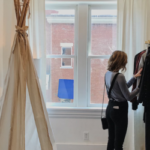12. Millennial Report: Young Adults Living At Home are Launching a New Luxury Retail Market
Living under a parent’s roof is hardly something to brag about for most young adults. We’ve all seen how the media portrays this arrangement: picture a hopeless loser lounging on an old couch in the basement with a slice of take-out pizza in one hand and a remote control in the other. But in reality, that image is far from the truth. For some folks, living at home is actually quite glamorous.
In 2020, over 50% of 18-29-year-olds moved back in with their parents, and many never left. Of course, some of these young adults are still itching to get out, saving every penny to survive the ever-growing costs of living. But others are perfectly content right where they are, as rent-free living affords them a lifestyle they couldn’t achieve independently.
These squatters are thriving, and luxury retailers are beginning to take note. Read on to learn more about this new market and how to shape your marketing efforts.
11. Millennial Report: When, How, and Where do Millennials Shop?
Insider Intelligence recently released a survey comparing Millennial shopping habits over the past 3 years. They asked Millennials when, how, and where they shop, and the results may surprise you.
Nearly one-third of Millennials prefer to shop during weekdays on their mobile devices from home. There’s a lot to unpack in that finding, but there are three big takeaways that retailers can use to shape their marketing and sales efforts. Let’s break down this research and discuss what you can do to accommodate these new trends.
10. Millennial Report: The Benefits of User-Generated Content
Everyone loves Super Bowl commercials, right? We all remember the iconic Pepsi ads over the years. It’s easy to appreciate the creativity that went into those commercials.
But if I’m being honest, I don’t typically find big-business marketing campaigns compelling. They often feel overly prescribed and inauthentic to me. And I’m not alone. Studies show young people “prefer seeing actual customers in promotional materials. As many as 82% trust a brand more if they use real customers in advertising, while only 26% of respondents trust a company more if they feature paid spokespeople.”
Unlike traditional marketing tactics, user-generated content (UGC) often seems more trustworthy and relatable than multi-million dollar ads. Audiences see themselves reflected in user-generated marketing and feel connected to the people behind the posts. Plus, UGC usually showcases a broader range of perspectives and diversity than we might see from traditional media sources.
In the world of marketing, user-generated content has become an immensely valuable asset. Let’s explore what UGC is and why it’s essential for ecommerce retailers.
9. Millennial Report: From Tamagotchis to Fanny Packs- Millennials are Willing to Splurge on Nostalgia
I’m a creature of habit. I wear only a few outfits on rotation (although you’d never know it from my jam-packed closet) and purchase roughly the same groceries week after week. However, last month I decided to branch out a bit and did something outrageous: I bought a new flavor of yogurt. Insignificant and, frankly, ridiculous as that purchase may seem, that one change in my routine completely altered my week. Here’s why:
The second I took a bite, I was instantly transported to a different time. It was a flavor I hadn’t tasted in over 20 years, since the nineties, although I couldn’t pinpoint what it was. The yogurt was shockingly tangy, too sweet, and absolutely disgusting—I would normally have wanted to spit it out immediately. But it was familiar in an almost comforting way.
After a few days of frantic Google searching—yes, days. I couldn’t let it go—I finally pinpointed the flavor. It tasted exactly like a yogurty treat with sprinkles able to change color, a favorite from my childhood. (Back in the days when kids were marketed yogurt with sprinkles.) Although the new yogurt I got was gross, and I never wanted to taste it again, the experience got me thinking about how important nostalgia is to my generation and how it affects our purchasing habits.
8. Breaking the Ice: Millennial Communication Anxiety in the Workplace
My first real job out of college was nothing short of a disaster. I found myself in a situation where I had little direction and big responsibilities. But at the time, I had no real knowledge of office or email etiquette and no mentor to guide me. Needless to say, I fumbled the entire way through my first year.
Most of my problems in this position revolved around communication. My questions were often met with annoyance, and occasionally hostility, so I quickly learned to stop asking. Of course, this resulted in me doing *quite literally* everything wrong.
My plan to wing it didn’t work out great for me, nor did the job—I didn’t stay there for long. But the pressure I felt at that first high-stakes, professional experience stuck with me and continues to affect my perception of my own competence.
This feeling of communication anxiety in the workplace isn’t some niche issue that a few pathetic Millennials like me experience. It’s actually enormously widespread among my age group.
Recent research from The University of Law found that 97% of individuals between 25 and 34 fear judgment by their colleagues over how they communicate at work.
I’ll repeat if for those in the back: 97%! That’s almost every single Millennial! Businesses must address this pervasive issue directly if they want to create a supportive environment that encourages open communication, collaboration, and transparency. By facing this head on, organizations everywhere can help alleviate Millennial communication anxiety and create a more confident and engaged workforce.
7. From Broke to Boss: The Rise of Millennial Prosperity
In 2008, Millennials’ economic future looked bleak. The Great Recession annihilated most of our potential job opportunities, and no one was sure how or if the generation would recover. But 15 years later, things have started looking up.
People still assume Millennials are barely scraping by; however, contrary to prevailing stereotypes, many of us are experiencing a notable improvement in our financial well-being. A recent study featured in Business Insider reveals an encouraging finding: the median household income for Millennials aged 35 to 44 has risen substantially from $66,693 in 2014 to $90,312 in 2021.
This research indicates that my demographic is finally headed toward brighter days. But what conditions have helped hoist us out of this rut? And now that we’re doing better, what does the future of Millennial spending look like? Let’s explore the implications of our financial progress on the evolving ecommerce landscape.
6. Millennial Report: The Power of Podcast Marketing
I wasn’t blessed with a low-energy lap dog that’s content laying by my feet and staring out the window all day. I have a tireless, attention-seeking beast that needs near-constant stimulation and multiple daily fetch sessions to avoid utter destruction. So to prevent myself from losing my mind as I monotonously throw his ball over and over again, I listen to podcasts.
In part, podcasts help keep my mind active. Plus, they provide a sense of community; I, like many of my Millennial friends, work from home and lack the comradery and culture of traditional workplaces. Listening to people banter and gossip helps fill that void.
Podcasts have surged in popularity among people under 40, particularly among Millennials and Gen Z. These digital audio gems offer a captivating escape from everyday life, covering a wide range of topics from pop culture to personal development. Because they’re on-demand, podcasts fit seamlessly into these generations’ busy, on-the-go lifestyles, providing convenient opportunities to learn, laugh, and connect. Their intimate and authentic nature fosters deep loyalty, making podcasts a go-to medium for staying informed and entertained.
For retailers, podcasts can be instrumental in engaging and attracting young demographics in a way that resonates with their digital-savvy sensibilities. So today, we’re exploring the reasons behind the surge in podcast consumption among Millennials and uncovering how you can leverage this trend to boost your ecommerce business.
5. The New Barbie Movie’s Impact on Retail: A Millennial Phenomenon
The entertainment industry has witnessed a nostalgic revival in recent years. One of the most remarkable success stories has been the return of Barbie, the iconic doll that has transcended generations. With its contemporary take on the beloved character, the new Barbie movie has sparked a retail revolution, particularly among Millennials.
Having been a Barbie-obsessed child, I can attest to the enduring allure of this archetypal doll. I vividly remember spending hours in my room, meticulously dressing my Barbies for glamorous adventures in my imaginary world. The Barbie movie’s impact on retail has rekindled those nostalgic memories, drawing me back into the world of Barbie once again.
The new Barbie movie’s profound impact extends beyond the silver screen, leaving its mark on brick-and-mortar stores and ecommerce retailers. Its captivating storyline has resonated with Millennials like me, influencing our shopping habits and preferences as a new segment in the retail landscape opens.
4. Bite-Sized Delights and Seltzer Nights: What’s Trending with Millennials in Food & Beverage Retail
The food and beverage retail landscape is undergoing a profound transformation, driven by the preferences and behaviors of younger generations, like Millennials and Gen Z. This shift presents a world of new opportunities for ecommerce retailers navigating the industry.
We’re delving into the latest trends shaping food and beverage retail and exploring a few ways ecommerce retailers can capitalize on them.
3. Unveiling the Future of Weddings: How Gen Z Is Redefining ‘I Do’
I refuse to attend another wedding. Don’t get me wrong; I genuinely adore my friends and wish them all the best, but the endless cycle of weddings has taken its toll. I used to smile as the bridal party walked down the aisle. But now, I cringe watching a gaggle of 10 bridesmaids, all clad in matching attire, resembling a Duggar family portrait. I’ve traveled far and wide and spent countless dollars on dresses that would see the light of day just once. I’ve spent more weekends in evening gowns than I have in my cozy pajamas, and I’m over it.
My wedding fatigue isn’t unique. As I peer into the horizon of the wedding industry, I’m beginning to see signs of change. Gen Z, the cohort following in my generation’s footsteps, is shaking things up.
The wedding industry is undergoing a significant transformation as Millennials exit their wedding years, making way for the rise of Generation Z. To remain relevant in this new era, wedding retailers and vendors must take note of these changes and adapt accordingly.
It’s time to embrace a breath of fresh air in an industry that’s long been overdue for a makeover. So let’s explore the evolving landscape of weddings, where Gen Z is rewriting the rulebook.
2. Millennial Report: TikTok Weighs In on eCommerce Experiences
While scrolling aimlessly through TikTok, I came across a viral video with a staggering 1 million views. UK-based family influencer Kelly Medina Enos–a name I hadn’t heard before—expressed her frustration with ecommerce sites. Here’s the gist of what she said:
This is a public service announcement to any brands that have a website:
Let’s say I’m scrolling through your site—first of all, continual scrolling or a “see all” button should be mandatory. I shouldn’t have to click through different pages—and I find a product that I’m interested in viewing. I click on that image, then I’m redirected to the product detail page. When I’m done, and I hit the “back” button, I should immediately be redirected to that exact product, not at the top of the page where I’ve lost my spot. If that happens, you’ve lost me as a customer. I’m not scrolling through your entire website just to get back to one product.
Many online shoppers agree with Enos’ thoughts—in fact, over 100K users liked this video. So it’s high time ecommerce retailers take note.
1. Millennial Report: Safeguarding Luxury in the Age of Dupes
The luxury retail sector has always navigated the tricky waters of counterfeit goods. These knock-offs, trying to pass off as the real deal, have been an age-old challenge for premium brands. However, today’s landscape is seeing an evolution of this issue, accelerated by platforms like TikTok.
The social media giant has popularized counterfeit luxury items, making them more accessible through dupe culture as highlighted by a new CNBC report. Following this trend, users openly share and seek out replicas that mimic high-end products, blurring the lines and making it easier for consumers to find and purchase these imitations.
For high-end retailers, this presents a modern challenge: how to uphold the value and exclusivity of genuine products in a marketplace that is increasingly normalizing the appeal of well-crafted fakes. Luxury retailers, especially in the digital domain, must confront this trend head-on, understanding its implications and devising strategies to maintain their client base and allure.




